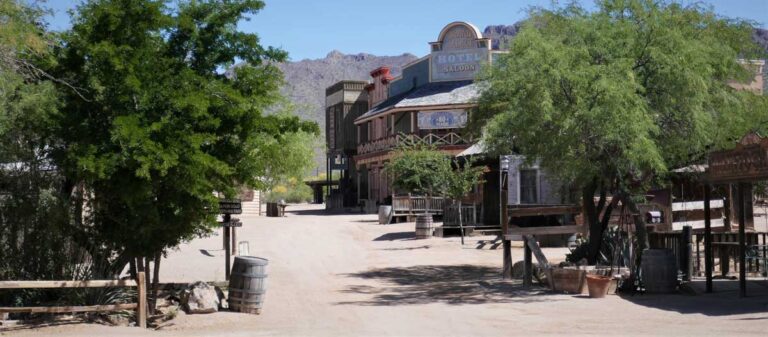
This much, everyone agrees on. At 3 p.m. on the cold, blistery afternoon of October 26, 1881, Wyatt Earp, his two brothers Virgil and Morgan, and Wyatt’s friend John “Doc” Holliday, set off down Fremont Street in Tombstone, Arizona.
Shootout at the O.K. Corral
They walked side-by-side. Virgil Earp was the acting town marshal; the other men had been deputized. Each man carried a six shooter, tucked in a belt or coat pocket. Doc Holliday also had a shotgun hidden under his long coat.
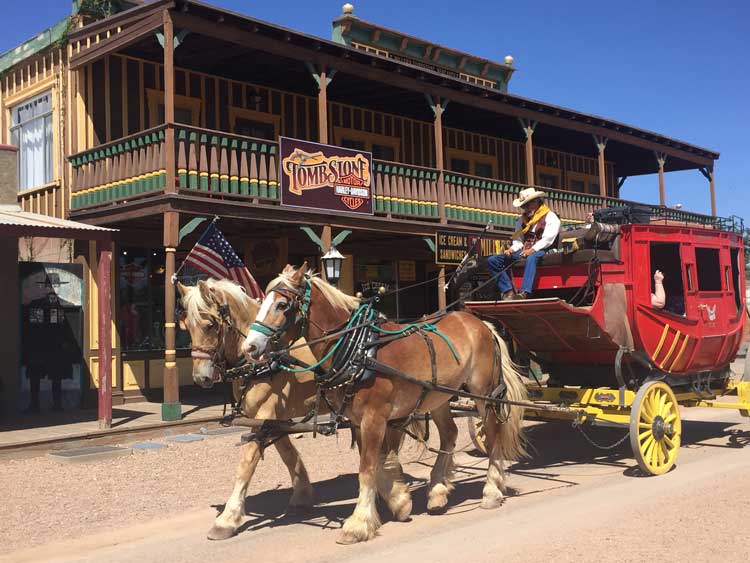
At a vacant lot on 3rd Street near the O.K. Corral, they confronted some cowboys — two sets of brothers, Ike and Billy Clanton and Tom and Frank McLaury. Billy Clanton and Frank McLaury were wearing pistols in holsters, a violation of town laws.
The two parties were about six feet apart when the air exploded in gunshots. Thirty shots were fired in 30 seconds. When the smoke cleared, three men were dead, three were wounded, and the history of the Wild West was changed forever.
What Happened at the O.K. Corral
What happened in those 30 seconds near the O.K. Corral has created controversy for 138 years. It’s been the subject of dozens of nonfiction books and magazine articles and influenced thousands of fictional portrayals of the Old West in novels and films.
Although no one will ever know exactly what happened in Tombstone, I wanted to know as much as I could.
Who were these men? What was it like to live in the Old West? And how did this violent gunfight become such an important and influential American legend?
I had to start somewhere, and I thought the first thing to do was to learn how to be a cowboy. And no place is better for that than the White Stallion Ranch in Tucson, Arizona.
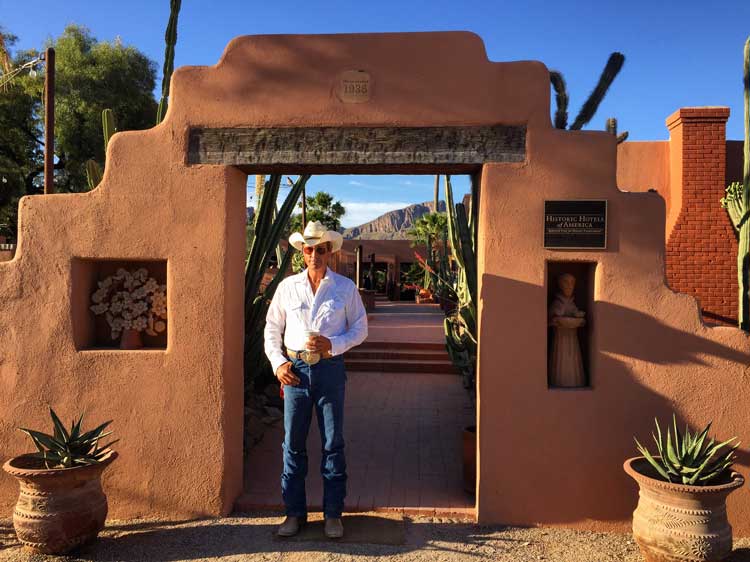
White Stallion Ranch
At first glance, the White Stallion offers little in common with life in the 1880s. Everyone at this dude ranch stays in their own little adobe casita, a small house decorated with blankets and western art and surrounded by immaculately groomed grounds of cactus, palm trees, and flowering bushes.
There’s a gorgeous swimming pool at the Arizona ranch, a bar with saddles for seats, and three delicious meals a day, often enjoyed outside on the patio after one of the chefs rings a large outdoor bell to let the whole ranch know vittles are being served.
Riding at White Stallion Ranch
And yet, life at the White Stallion offers many glimpses into the past. The dude ranch has 170 horses and it’s a rare moment when you don’t hear a horse whinnying or see one in the corrals. There are daily rides for all levels out into their scenic 3,000-acre Sonoran Desert ranch, where tall, multi-limbed saguaro cactus tower up, just like in Western movies, framing distant views of mountains.
It’s a wonderful time tripping experience to sway on a horse and see and feel the dust kick up, as you mosey along under a big sky through a stark desert landscape.
And it’s especially wonderful, when after an hour in the saddle, you ride up to a pavilion where ice cold white wine and cheese is served. Doc Holliday would have loved that. But chilled white wine aside, the truth is soon apparent.
It doesn’t take much of this riding in the desert business to convince you that cowboying is hard work. And while fun for a few hours every day, it could also be dangerous.
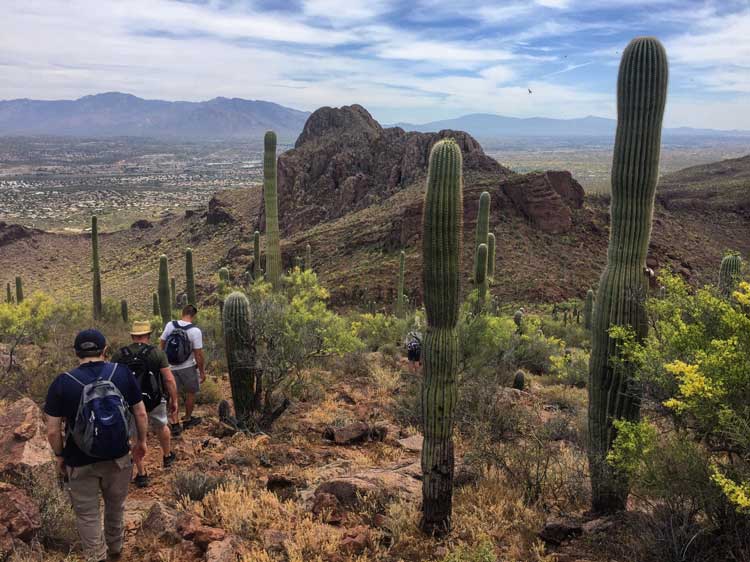
Hiking to Panther Peak
That was especially rubbed in when I joined nine others on a guided four-mile hike up Panther Peak, which looms over the ranch. In two hours of dodging rattlesnakes and cactus spines, we gained 1,300 feet in elevation, acquiring a lot of knowledge about the desert in the process.
We encountered a rattlesnake (when rattling it sounds like a loud sprinkler), slid up and down rocks burned black by the sun, and learned first-hand why everybody needs to bring two liters of water with them when venturing into the desert.
After maneuvering through fields of jumping chollas cactus, I will never take a Western movie for granted again. Until you ride two miles in a cowboy’s stirrups, you can’t appreciate what the Old West was like. You soon understand the type of men who would choose this as an occupation. Hard men living a hard life.
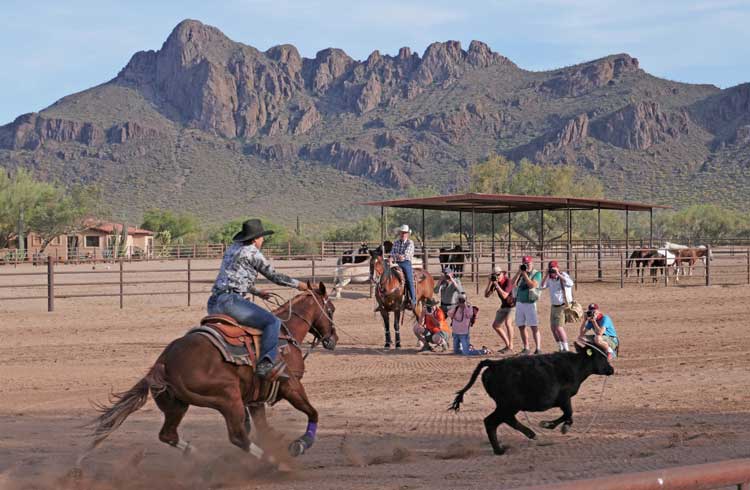
Ranching Life at White Stallion
Meanwhile, back at the ranch, life at the White Stallion is very pleasant, sort of like a cruise ship docked in the desert. You can do as much, or as little as you like. You can learn to rope (much harder than it looks!), herd cattle, or fire replicas of the guns that won the West: the Winchester, the Henry rifle and a peacemaker pistol, similar to the .44 caliber 1869 Smith & Wesson revolver Wyatt carried in Tombstone.
Shooting, I learned, is also tough. With the rifle resting on an arm pad, it’s easy to hit large targets. But even with two hands holding up a six shooter, it’s hard to hit anything with a pistol. The thought of firing a handgun from a horse with accuracy suddenly seems ludicrous, not to mention firing one when someone is shooting back at you.
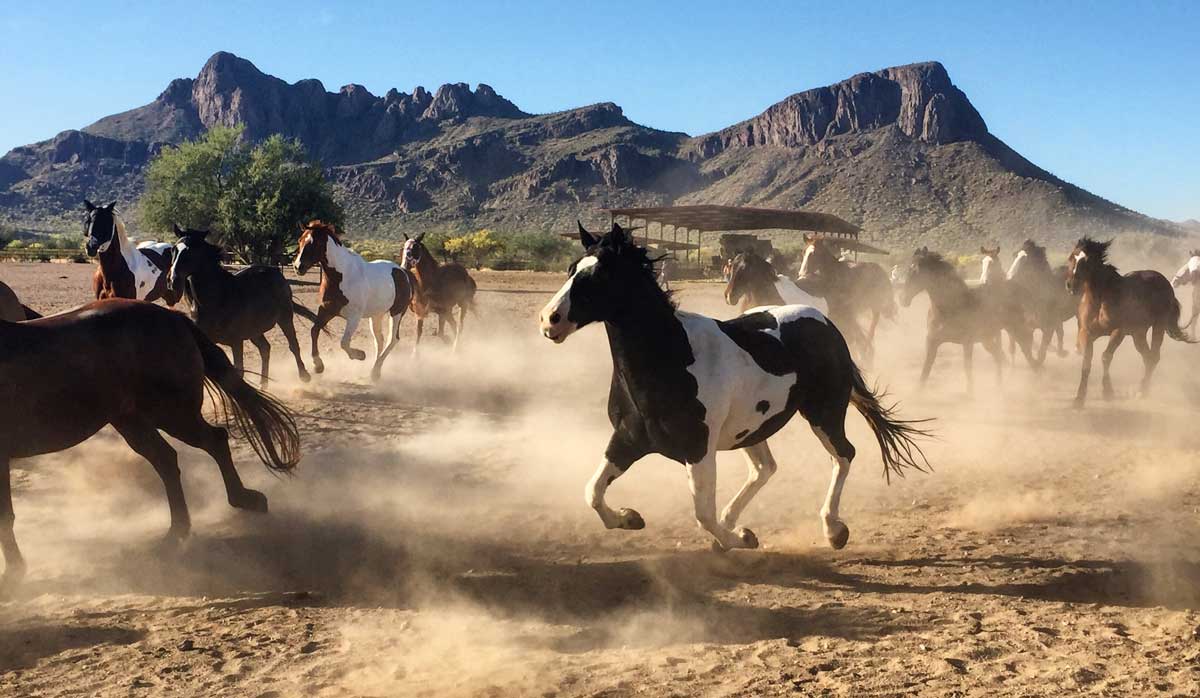
History of the White Stallion Ranch
The White Stallion Ranch property was originally homesteaded in the 1900s and first became a dude ranch in 1945, when Tucson was the dude ranch capital of the nation with more than 100 ranches attracting the Hollywood elite, the rich and famous and the ordinary folks who wanted to be cowboys. Many movie stars stayed here in the glorious era of the 1940s and 1950s, enjoying the desert air while making films nearby.
Today, there are only two dude ranches left in Tucson. It’s a shame that this form of travel has declined, but the White Stallion is doing a brilliant job of keeping it alive. The True family have owned the ranch since 1965 and are dedicated to give a complete Western experience.
The whole family works at it, so you’ll meet family members serving meals, leading horseback riding expeditions or tending the bar.
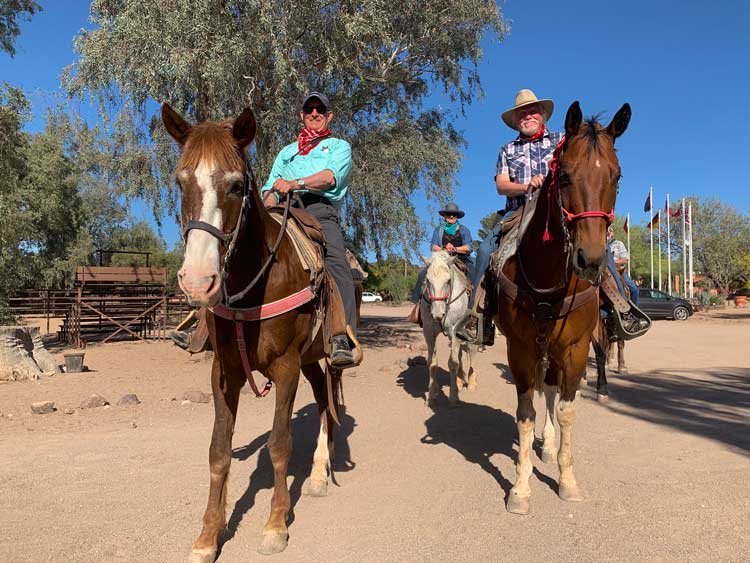
Evening entertainment varies from a weekly rodeo (put on by the wranglers and members of the True family) to an exciting display of gun slinging and trick roping by Loop Rawlins, one of the finalists on America’s Got Talent.
But for me, the most memorable night was hearing cowboy singer Bill Ganz strum a guitar and sing ballads by a campfire under the desert stars. In this setting, after a day of riding and shooting, it’s easy to realize how the romance of the West became such a popular form of entertainment, even if the real thing was sometimes very different.
Old Tucson and the Legend of the O.K. Corral
One of the most fun experiences at the White Stallion is taking the movie tour with film historian Marty Freese. More than a dozen films were made at the White Stallion, most famous being the last shootout in the classic Western Winchester ’73 with James Stewart.
They also shot the full-length movie of the Lone Ranger TV series here, and The Last Outpost, in which Ronald Reagan led a cavalry charge of 35 troopers across the same patch of desert we had ridden horses on the day before. Marty takes guests around to various sites and with the use of still photos from movies, shows you the location where they were shot.
Hollywood in Old Tucson
The first big “Hollywood” film made in Arizona was, appropriately named, Arizona, a 1940 blockbuster with William Holden and Jean Arthur. The dramatic stampede scene was filmed on the White Stallion Ranch.
To create the town of Old Tucson used in the movie, the producers went down the road a few miles and built an “authentic” Old West town from scratch, some 65 buildings, many of them made with real adobe bricks.
Seventy-nine years later, it’s still there. More than 300 films have been shot in Old Tucson, including parts of the Kurt Russell and Val Kilmer film about Wyatt Earp and Doc Holliday, Tombstone and the shootout scene in The Gunfight at the O.K. Corral, this time with Burt Lancaster as Wyatt and Kirk Douglas as Doc.
Movies in Old Tucson
Today, Old Tucson is a hoot – sort of a theme park, film studio, museum and stunt show extravaganza. They’re still recovering from a devastating fire in 1995 that destroyed 40 percent of the film location, but there’s plenty to see and do, from hopping aboard a stagecoach to riding a miniature train to taking a serious motion picture walking tour with Marty Freese, that points out actual filming locations.
John Wayne and Clint Eastwood both made movies here. Since the buildings are primarily for films, many have only three walls, but the illusions as you walk the many Old West streets are great.
The most recognizable thing? It’s Golden Gate Peak in the background. The mountain along the horizon has been a backdrop in hundreds of films and TV shows from Bonanza to High Chaparral.
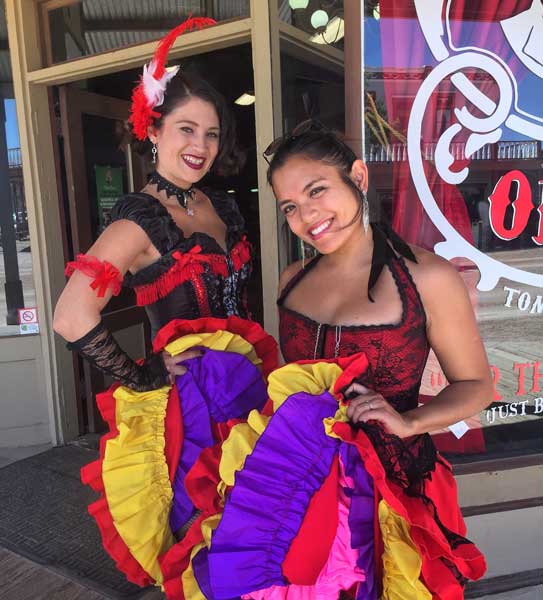
Tombstone, Arizona: The Town Too Tough to Die
The real Tombstone is about 90 miles southeast, and there’s no denying it, the town can rub different people different ways. To some, it is the ultimate tourist trap, three long blocks of souvenir shops, dubious historical museums like the “Gunfighters Hall of Fame,” fake shootouts, can-can dancers, loud saloons, and odd characters, who walk around in Old West outfits carrying real guns.
Ironically, in the Tombstone of 1881, guns were prohibited in town; in modern Tombstone it’s legal to walk around wearing a real gun (although almost every shop and saloon has signs saying “No Firearms Allowed.”
So yes, Tombstone can strike some people like that. But to me, it was simply amazing. Here was the spot where Curly Bill Brocius shot down Marshall Fred White on a town street; here’s the historic Birdcage Theatre, where the longest poker game in history was played (it lasted 24-7 for eight years).
For every tourist shop, there is a respectable Old West bookstore, antique shop or authentic museum, like the Tombstone Epitaph, where you can see the presses that printed the first account of the gunfight (and get an actual reproduction of the front-page story).
There are two great looking stagecoaches traveling up and down Allen Street, plank board sidewalks to walk on, Boot Hill Graveyard, Big Nose Kate’s Saloon (where the Kurt Russell film Tombstone plays continuously on a large screen) and if you come early in the morning, there are empty streets that you can have all to yourself. Cowboys must sleep in.
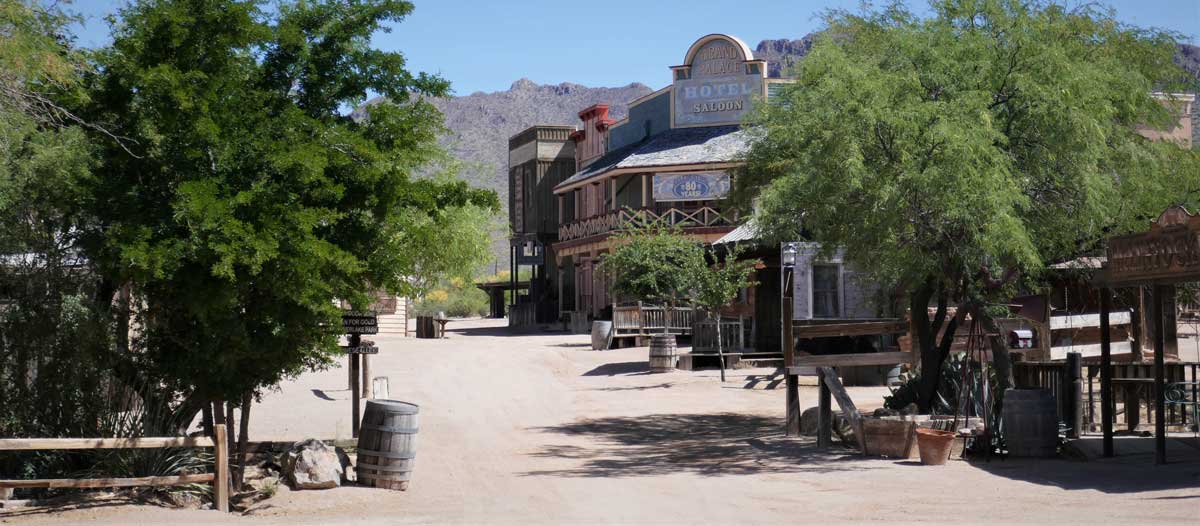
Gunfight at the O.K. Corral
And then there’s the O.K. Corral. Okay, it’s corny. There are terrible mannequins standing where the gunfighters stood. You press a button and they talk, raise their arms very mechanically and fire. The live show is almost worse. The gunfight lasted only 30 seconds, so to give people their $10 worth, there is a theatrical stage a fake backdrop, and an audience participation “show” where spectators are encouraged to “boo” the Clantons.
Bad showmanship aside, this is where the gunfight happened. Exactly what happened is the question.
The Earps, the museum points out, were not quite the heroic figures often portrayed in films. Wyatt was living with his prostitute “wife,” who he later abandoned and was a marginal figure who had been a deputy marshal in Dodge City and Tombstone, but mostly made his living from running gambling operations. Doc Holliday was dying from tuberculosis, a hopeless alcoholic, constantly fighting with his prostitute wife (Big Nose Kate) and a gambler and killer.
Virgil Earp
Virgil Earp was acting town marshal after Fred White was murdered and in this powerful position, he and his brothers were able to make a good living. They were also in a position to make enemies, most notably with a group of cowboys who were also rustlers and horse thieves, stealing cattle from Mexico.
At this time, “cowboy” was a derogatory term, and the men who carried it were rough characters living a hard life stealing, and a wild life celebrating in town afterwards. It was natural that the Earps and the cowboys would clash.
The day before the gunfight, Ike Clanton got horribly drunk and threatened to shoot the Earps on sight. The next day at 1 p.m., after no sleep and continual drinking, Ike carried a gun on to the street, a violation of the town laws.
Virgil Earp, as town marshal, pistol-whipped Ike over the head from behind, arrested him and had him fined $25. At the courthouse, Wyatt accidently bumped into Tom McLaury, words ensued, and Wyatt coldcocked Tom over the head with his pistol twice.
The wounded and furious cowboys went down to a vacant lot behind the OK Corral where they were joined by their brothers Billy Clanton and Frank McLaury. Perhaps they intended to leave town, perhaps they intended to murder Doc Holliday, who lived next door. At any rate, two were wearing visible guns, which was against the law, and making threats about shooting the Earps on sight.
Word got back to Marshall Virgil Earp and at 3 pm, he decided to end the situation. Moran and Wyatt Earp were sworn in as deputy marshals. Doc Holliday insisted on coming, and he too was sworn in. Virgil maintained he wanted to disarm the cowboys without trouble. To look less threatening, he gave his shotgun to Doc, and took Doc’s cane.
The lawman walked down Fremont Street, turned into the lot and confronted the cowboys. Standing 6 to 10 feet apart, Virgil commanded, “Throw up your hands; I have come to disarm you!” Both sides had single action revolvers, which meant they had to be cocked before they could be fired. The sound of guns being cocked was heard. Virgil yelled: “Hold! I don’t mean that!”
After the Gunfight
Two shots were fired simultaneously. No one knows by whom. Then all hell broke loose. Wyatt shot Frank McLaury in the stomach. Tom McLaury, who may have been unarmed, was behind a horse.
When he pushed himself free, Doc Holliday blasted him at close range with a shotgun and he stumbled down the street dying. Doc then threw away the empty shotgun, pulled his pistol, and began blazing away at Billy and Frank.
Ike Clanton was unarmed. He grabbed Wyatt and tried to make it clear he had no gun. Wyatt said, “Go to fighting or get away!” and Ike Clanton turned and ran. Frank McLaury had been shot in the gut, and Billy Clanton was wounded in his right hand, but coolly transferred his gun to his left. They both died game, returning fire.
Morgan was shot across his back and went down, Virgil was shot in his calf, while Doc took a shot that grazed his hip. Wyatt stood, one witness said, “as cool as cucumber” and fired away. Frank, wounded several times, finally took a shot to the head, fired by either Morgan or Doc. Billy lay in the dirt, also dying, clicking his revolver on empty chambers and asking for more cartridges.
What Happened Next
It was over. But the follow-up was just as contentious. And just as bloody. The Earps were tried for murder and acquitted. Two months later, Virgil Earp was shot in the back and his arm permanently maimed. Then in March 1882, Morgan Earp was assassinated, shot in the back while he was playing pool. A second bullet narrowly missed Wyatt.
Virgil took his family and left for California, but Wyatt, now a Deputy U.S. Marshal, and Doc formed a posse and set out on what was called “the Vendetta Ride.” Who exactly shot whom is up for debate, but in the next few weeks, four of the outlaws suspected of Morgan Earp’s murder were all dead.
Ironically, at the end of the ride, there were murder warrants out for both Wyatt and Doc. They left Arizona for Colorado, where Doc died in a bed in Glenwood Springs.
Josephine Marcus
Wyatt roamed the west for next 46 years with his new common-law wife, Josephine Marcus, an actress who just happened to playing in Tombstone at the time of the gunfight. She was portrayed in the film Tombstone by Dana Delany.
Theirs appears to have been a true love affair and they opened and worked in saloons from Alaska to California, Wyatt constantly searching for fame, but never truly achieving it in his lifetime. He died in Los Angeles in 1929 in negotiations about making a film of his life story.
TV Films on the O.K. Corral
A few films were made about the infamous gunfight in the 1940s, but it was in the 1950s, during the ambiguous times of the Cold War that television finally made Wyatt Earp a star.
At this time, Americans wanted simple entertainment on TV, good guys versus bad, and the idea of a group of Marshals and deputies walking down a western street to face-off against cowboys and outlaws captured everyone’s imagination.
Though this was one of the few stand-up gunfights in the history of the Old West, it became the norm and was re-created in hundreds of different versions in books, movies and TV shows.
Through it all, Wyatt Earp became the most famous U.S. Marshal on the frontier. He was “brave, courageous and bold,” as his TV song said, even if the real Wyatt Earp had run prostitutes, been a gambler, had only been a deputy marshal on a few occasions and was wanted for murder.
Still, this part is true. On that October day in 1881, the Earp brothers and Doc Holliday stuck pistols in their belts and walked down a dusty street to face an unknown number of cowboys, who they believed were also armed. And they did it to enforce the law.
When you retrace their steps down the same dusty street in Tombstone and see the sign for the O.K. Corral at the end of the block, well, if you’ve ever loved a Western movie, it’s a moment you won’t forget.
If You Go to Tombstone
Tombstone Arizona Visitors Information
Author Bio: Rich Grant is a freelance travel writer in Denver, Colorado and a member of the Society of American Travel Writers and the North American Travel Journalists Association. He is, along with Irene Rawlings, co-author of “100 Things to Do in Denver Before You Die,” published by Reedy Press in 2016.
